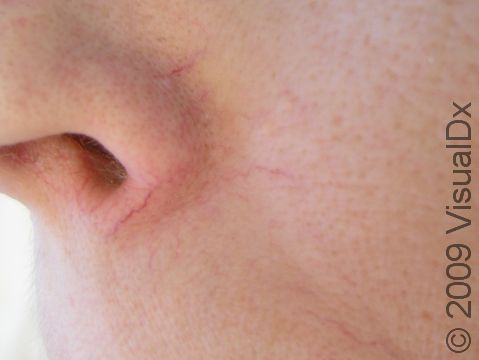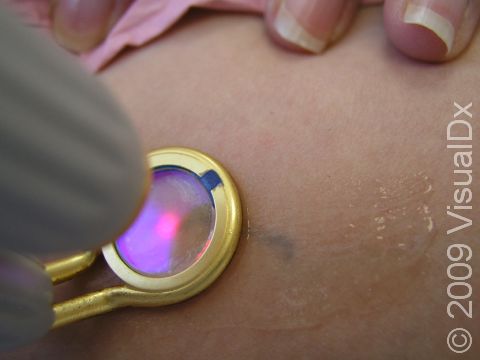Vascular Lesion Treatment, Laser
There are several types of vascular lesions of the skin, including certain birthmarks (eg, port-wine stain), spider veins, varicose veins, and some growths (eg, pyogenic granuloma), that can be treated with lasers. The redness and tiny blood vessels of rosacea are also amenable to treatment with laser. Medical professionals such as board-certified dermatologists who specialize in laser surgery and the technicians they supervise can use a variety of lasers to selectively treat blood vessels while leaving the surrounding tissue undamaged.
People who may benefit from laser vascular lesion treatment include those with widespread redness (many fine blood vessels), individual bothersome blood vessels, or both. The type of laser used by your medical professional uses will depend on the type of vascular lesion to be treated as well as your skin color.
What to Expect During Your Visit
Prior to treatment:
- Avoid sun exposure, especially midday, use a broad-spectrum sunscreen (one that protects against both UVA and UVB rays) with SPF 30 or higher, and wear sun-protective clothing (eg, a hat and tightly woven clothing).
- Avoid medications and supplements that make bruising more likely (only if directed by your medical professional), including:
- Aspirin.
- Ibuprofen.
- Vitamin E.
- Gingko and ginseng.
- Fish oil supplements.
- Prescription blood-thinning medications (eg, warfarin or heparin).
The medical professional may apply a topical anesthetic for 30-90 minutes before the procedure to numb the area. They will then clean the area to be treated. Then you, the medical professional, and anyone else who may be in the room will put on appropriate eye protection. Next, the medical professional will program the machine with appropriate settings and place a handpiece on the skin, and either a trigger or foot pedal is used to fire the pulse of laser energy targeting a 1-3 cm area of skin. The sensation during treatment is very brief and is often described as a heated pinprick for each laser pulse. The topical anesthetic will help to numb this sensation, though. Treatment times vary due to the size of the area to be treated and machine used, but a typical treatment takes approximately 15-30 minutes.
What to Expect After Your Visit
After treatment, the skin is temporarily swollen and sometimes temporarily lighter than the surrounding skin. Bruising is a common effect of vascular lasers. Occasionally, blistering can occur. It may take up to a month to see the full effects of the treatment, but the final result is permanent.
Follow-Up Care
- Wearing sunblock and avoiding the sun for a month is important following the laser procedure.
- Do not rub or pick at the skin while it is healing.
- Cold compresses can help with redness and swelling.
- Sleeping with your head elevated can allow swelling to drain from the head.
- If the treatment area blisters or crusts, you can use petroleum jelly (eg, Vaseline) or an antibiotic ointment until the area has healed.
Risks and Potential Side Effects
When used by well-trained laser surgeons, risks such as blistering, discoloration, or scarring are very low. Expected side effects include redness and sometimes bruising lasting for a few days. Avoiding blood-thinning medications can reduce the risk of bruising.
When to Seek Medical Care
Seek medical care if the area is not healing or if there are signs of infection (such as pain, spreading redness, or fever).
References
Reddy KK, Geronemus RG. Laser Treatment of Cutaneous Vascular Lesions. In: Geronemus RG, Bernstein LJ, Hale EK, Brightman LA, Karen JK, Weiss ET, Anolik RT. eds. Lasers and Related Technologies in Dermatology. McGraw-Hill Education; 2013. Accessed April 23, 2024.
Wall TL. Current concepts: laser treatment of adult vascular lesions. Semin Plast Surg. 2007;21(3):147-158. doi:10.1055/s-2007-991183
Last modified on May 9th, 2024 at 2:17 pm

Not sure what to look for?
Try our new Rash and Skin Condition Finder


